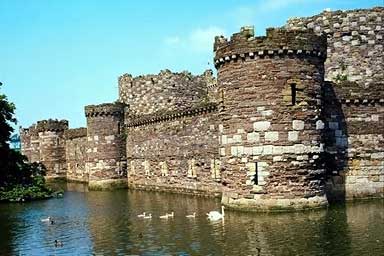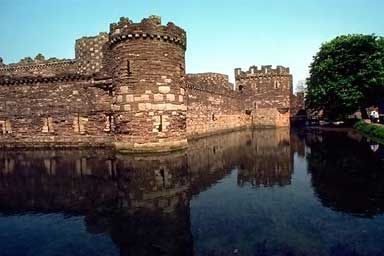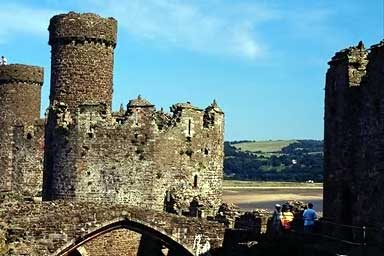|
| |
Name: Beaumaris
Location: Anglessey, Gwynedd
Country: Wales
Review this castle

Beaumaris. is the eight and last and most elegant of Edward's I Welsh
castles, expressed the idea of concentricity and covering firepower to
perfection. It was never completed according to the plan, however because money
ran out.
Edward I wanted to consolidate his conquest of North Wales by building Beaumaris.
Beaumaris is the last of the castles built by Edward I during and after his conquest of Wales. Its design, by Master James of St George, is almost perfectly concentric. It cost nearly 015,000; it took over 35 years to build,
and even then was not completed. At one time over 3500 people were working on it, which is thought to be about 1 in 1000 of the total population of England and Wales at the time (1295). It was considered impregnable, but this was never put to the test. No shot appears to have been fired at Beaumaris in anger. And within 20 years of the last, but unfinished, building operations (c.1330), the castle was reported to be deteriorating: most of the timberwork was in decay and some stonework was dilapidated.

View of the outer defense system. The wall with its numerous
towers, rises up from the moat. The slightly projecting parapet walk is
supported by small, closely spaced corbels. |
Beaumaris is situated strategically in flat, marshy land on the south edge of the Isle of Anglesey. The castle is basically two concentric wings of walling with flanking towers and gatehouses. The inner ring, square in plan, with walls about 4.9
meters (16 ft) thick and nearly 13.1 meters (43 ft) high, has cylindrical towers on the four corners,
D-end towers mid-wall on the west and east and, on the north and south, a substantial
twin cylindrical-towered gatehouse mid-wall, the northern one completed, the southern one lacking its rear portions. None of the towers or gatehouses was completed to its full height. Both gatehouses were fitted with two suites of apartments, making them residential. Indeed, the gatehouses were the strongest parts of the castle, acting as great
towers.
|

Represents one of the peaks of Gothic fortifications; it is described
as the most perfect of all concentric castles.
|
The outer ring, whose wall is 8.2 meters (27 ft) tall and about half as thick as the inner walling, is octagonal in plan and has cylindrical flanking turrets all round from the extreme
south-west to the extreme south-east there are twelve in all. On the north-east side is an outer gateway, and on the southwest is the sea gate, which abuts on to a dock provided for supply vessels to moor close to the castle. The whole castle is surrounded by a broad wet moat supplied by the waters of the Menai Straits.

Beaumaris has two great gatehouses, a moat and an elaborate
system of fortifications with the inner defenses commanding the curtain wall.
Each section was built so it could be defended separately even if the rest
has been taken.
The castle was built of grit and limestone rubble from a nearby quarry at Penmon. Both rings of wall and also the towers and gatehouses were equipped with arrow slits all round, providing the maximum covering fire from all angles against attack from any direction. The southern gatehouse was further protected by a barbican.

Beaumaris was
surrendered to the parliamentarians in 1648 but escaped the usual
destruction. It remains on of the best preserved concentric castles in Britain.


Last of Edwards I's great ring of castles. Beaumaris was
surrendered to the parliamentarians in 1648 but escaped the usual
destruction. It remains on of the best preserved concentric castles in Britain.
| Tom Goldsmith, 18, from UK, wrote: |
| Beaumaris Castle on the Island of
Anglesey is the great-unfinished masterpiece. It was built as one of the
'iron ring' of North Wales's castles by the English monarch Edward I, to
stamp his authority on the Welsh. But it was never finished money and
supplies ran out before the fortifications reached their full height.
Beaumaris is nonetheless an awesome sight, regarded by many as the
finest of all the great Edwardian castles in Wales. Begun in 1295, it
was also the last. The king's military architect, the brilliant James of
St George, brought all his experience and inspiration to bear when
building this castle, the biggest and most ambitious venture he ever
undertook. In pure architectural terms Beaumaris, the most technically
perfect castle in Britain, has few equals. Its ingenious and perfectly
symmetrical concentric 'walls within walls' design, involving no less
than four successive lines of fortifications, was state of the art for
the late 13th century. The stronghold stands at one end of Castle
Street, inextricably linked with the history of the town. This was the
'beau marais' (fair marsh) that Edward chose for a castle and garrison
town. From the outside, Beaumaris appears almost handsome. It does not
rear up menacingly like other fortresses buts sits contentedly in a
scenic setting overlooking mountains and the sea, partially surrounded
by a water filled moat. The gate next-the-sea entrance protected the
tidal dock which allowed supply ships to sail right up to the castle.
Beaumaris is endlessly fascinating. There is so much to see here, the 14
separate major obstacles that any attacker would have to overcome, the
hundreds of cleverly sited arrow-slits, the deadly use of 'murder holes'
to defend entrances. This outstanding fortress is a World Heritage
inscribed site. |
| James Appleton, 14, from England, wrote: |
| At first sight Beaumaris is
disappointing, but once inside all preconceptions fade. it is massive,
and the views from the inner walls are amazing. I went there with my
history set to research it as we are doing our G.C.S.E coursework on it.
It is left alone by many tourist, unlike Conwy and Harlech, but is much
better then both of them. other people in my history set think it
wonderful, especially Joe Stewart, Ross Maylor, Mike Blake and Jonathan
Rawling. we all go to Calday Grange Grammar school for boys, near Birkenhead
and Liverpool on the Wirral. if anyone wants any more information on it,
please feel free to email me. |
| Dave Basford, 35, from England, wrote: |
| This castle is initially unimpressive when compared to
other castles (Caernarfon, Conwy, Harlech) as it was never completed and
the towers were never to achieve any height. But the water-filled moat
and the view once inside make this a remarkably beautiful castle.The fully symmetrical shape is afforded by the flat land on which it's
built and the views over the Menai Strait (between the island of
Angelsey and the Wales mainland) and over the northern part of the
Snowdonia |
| Gareth Meardon, 17, from England
wrote: |
| During the Crusades there were
little or no castles throughout Europe but when the Crusaders (Teutons
and Britons) saw huge stone castles in the East, they were astounded.
Constantinople was the biggest and a city in its own right. From then on
castles started cropping up all over Europe and Britain. Beaumaris was
the first concentric castle to be built in Britain (Symmetrical on both
sides) with small outer walls and large inner walls to defend over the
heads of the outer defenders. It was built by Edward to mainly show the
enemy the amount of power the English had over them. The Welsh
rebels were the main threat, however it was never completed and never
saw combat. Edward died before completion, but if it was completed, it
was most definite that it would have been destroyed by Cromwell and the
big parliament guns in the English civil war during the 15th century.
(that's
if King Charles garrisoned it which was probable. |
Have you visited a castle?
Do you know something about a castle?
If so, write something about it here.
Review this castle
|